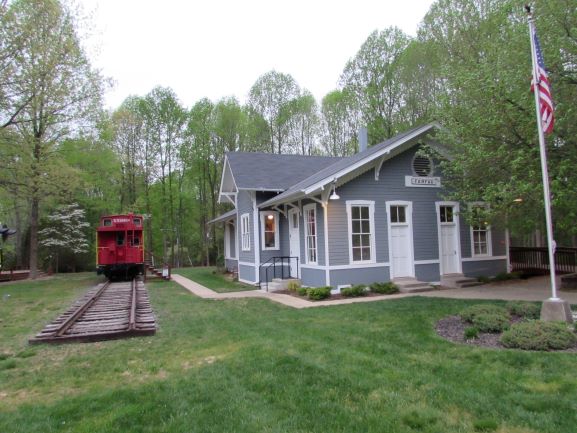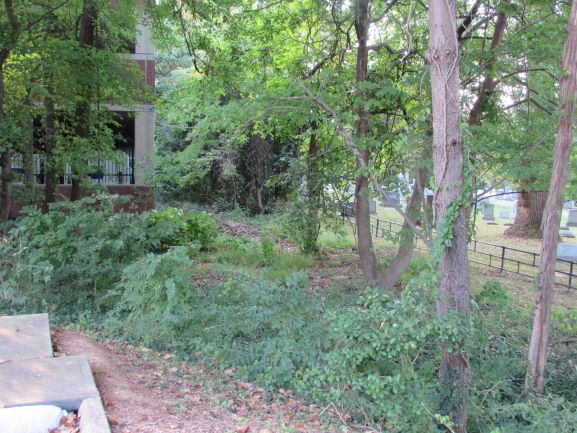
Fairfax, Virginia is a suburb of Washington, D.C. that is west of the city, and it is the county seat of Fairfax County. The town was established in 1805 and named after Thomas Fairfax. It played a role in the American Civil War as it was the site of the first land battle of the war (after the first shot fired at Fort Sumter) known as the Battle of Fairfax Courthouse. A second battle took place here years later days before the battle of Gettysburg. Although the Confederates won the battle, it impeded their progress in their march to Gettysburg. Although Virginia was a Confederate state, Fairfax was a Union stronghold. Blenheim, a brick farmhouse, was used as a hospital. The Gunnell House was also the site of a night raid by John Mosby (known as the ‘Gray Ghost’) who invaded the home at night and kidnapped a Union officer while he was in bed and rode him out of town on a horse. With all this history, only the Gunnell House remains in its original location. Blenheim was relocated less than a mile from its location, and the battlefield was overrun with development.
You read all of this, and say to yourself, “This would have been a great town to have a railroad pass through.”
It would have been a great town to have a railroad, and that was part of the plan for the Manassas Gap Railroad. A line had already been built between Mount Jackson, Virginia and the junction with the Orange and Alexandria Railroad in Manassas Junction (Manassas today). A line was proposed to branch off from Gainesville and run a few miles north of the Orange and Alexandria’s line passing through the towns of Chantilly, Fairfax and Annandale and ending up in Alexandria. This would have allowed the farms of the Shenandoah Valley direct access to the ports of Alexandria without depending on the Orange and Alexandria and the Baltimore and Ohio. Construction of this line began in the 1850’s. The costs began to be more than expected, and the Civil War happened. Much of the money went to funding the war effort. The line was abandoned without any tracks being laid.

Although development destroyed most of the original Manassas Gap Railroad bed, there are places where some of it remains. In Annandale, you can visit the Hidden Oaks Nature Center to see some of the original roadbed, and you can walk on the roadbed at the Manassas Gap Railroad Historic Site. A small section of the roadbed can be seen in Fairfax on Judicial Drive between Page Drive and Main Street. There is a section that runs through the property of the Sully Historic Site in Chantilly. You can also see sections of the roadbed on the Manassas National Battlefield.
Did Fairfax ever get a railroad? There was an electric trolley line known as the Washington, Arlington and Falls Church that did run from Arlington to what is now the Old Town of Fairfax. It arrived in Fairfax in the early 1900’s with the terminus of the line at the Old Courthouse on the corner of Main Street and the Chain Bridge Road. Service ceased in the 1940’s, and the tracks have been taken up although there are a few remnants of the line in the town.
With the trolley line gone and the Manassas Gap Railroad abandoning their rail line, how would the people of Fairfax have access to the rest of the nation other than by horse? The closest rail line was the Orange and Alexandria Railroad which was four miles south by way of the Ox Road.
In 1851, the town of Lee’s Station was established where the Ox Road crossed the Orange and Alexandria Railroad. A year later, the town was named Fairfax Station after its proximity to the town of Fairfax. The town began as a simple train station, but other structures were built to include Saint Mary’s Church, the oldest Catholic church in Fairfax County. The church attendees were immigrants from Ireland who came to work on the railroad. It was just a simple town until the Civil War came. In 1862, the church became a hospital. Wounded from the Union and Confederacy were brought from the second Battle of Manassas by train to the train station, and they were taken to the church to be cared for. Among the caretakers was a lady named Clara Barton. It was this incident and a few others that motivated her to found the American Red Cross. There was also a small skirmish that took place here on the grounds of the church.

When the war was over, Fairfax Station went back to a simple stop on the Orange and Alexandria Railroad. The railroad line changed ownership through the years, but passenger trains continued to stop at the depot until 1973. The depot was abandoned. It was about to be demolished, but a local organization known as ‘Friends of the Fairfax Station Incorporated’. The depot was moved to a safe location away from the tracks and converted into a museum. Today, you can visit the museum (https://www.fairfax-station.org) and learn about the history of the region. It is one of only three surviving train stations in Fairfax County, Virginia, and it is the only train station in the county that is in proximity of a railroad line.
What about Fairfax itself? Fairfax Station is today just a name. The trains pass through without stopping. They stop in Alexandria. They stop in Manassas. There are commuter train stops in the county with an Amtrak stop in Burke, but no trains stop at Fairfax Station. Although Fairfax has grown tremendously through the years, the old town pales in comparison to the old towns of Manassas and Alexandria. What if the Manassas Gap Railroad had completed its line? What if passengers were able to pull up in the old town like they can in Manassas and Alexandria as opposed to traveling four miles from town? For now, Fairfax is just an old town between two larger more popular old towns that have railroads.
John Cowgill – Photographs and text Copyright 2019